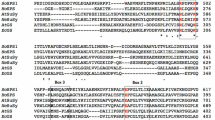Abstract
d-Psicose 3-epimerase from Agrobacterium tumefacience catalyzes the conversion of d-fructose to d-psicose. According to mutational analysis, the ring at position 112, the negative charge at position 156, and the positive charge at position 215 were essential components for enzyme activity and for binding fructose and psicose. The surface contact area and distance to the bound substrate by molecular modeling suggest that the positive charge of Arg215 was involved in stabilization of cis-endiol intermediate. The distances between the catalytic residues (Glu150 and Glu244) and Mn2+ are critical to the catalysis, and the negative charges of the metal-binding residues are important for interaction with metal ion. The kinetic parameters of the D183E and H209A mutants for metal-binding residues with substrate and the near-UV circular dichroism spectra indicate that the metal ion bound to Asp183 and His209 is involved not only in catalysis but also in substrate binding.


Similar content being viewed by others
References
Brooks BR, Bruccoleri RE, Olafson BD, States DJ, Swaminathan S, Karplus M (1983) CHARMM: a program for macromolecular energy, minmimization, and dynamics calculations. J Comput Chem 4:187–217
Goodsell DS, Olson AJ (1990) Automated docking of substrates to proteins by simulated annealing. Proteins 8:195–202
Itoh H, Okaya H, Khan AR, Tajima S, Hayakawa S, Izumori K (1994) Purification and characterization of d-tagatose 3-epimerase from Psedomonas sp. ST-24. Biosci Biotech Biochem 58:2168–2171
Jain AN (2003) Surflex: fully automatic flexible molecular docking using a molecular similarity-based search engine. J Med Chem 46:499–511
Kim HJ, Hyun EK, Kim YS, Lee YJ, Oh DK (2006a) Characterization of an Agrobacterium tumefaciens d-psicose 3-epimerase that converts d-fructose to d-psicose. Appl Environ Microbiol 72:981–985
Kim K, Kim HJ, Oh DK, Cha SS, Rhee S (2006b) Crystal structure of d-psicose 3-epimerase from Agrobacterium tumefaciens and its complex with true substrate d-fructose: a pivotal role of metal in catalysis, an active site for the non-phosphorylated substrate, and its conformational changes. J Mol Biol 361:920–931
Kim NH, Kim HJ, Kang DI, Jeong KW, Lee JK, Kim Y, Oh DK (2008) Conversion shift of d-fructose to d-psicose for enzyme-catalyzed epimerization by addition of borate. Appl Environ Microbiol 74:3008–3013
Lim BC, Kim HJ, Oh DK (2009) A stable immobilized d-psicose 3-epimerase for the production of d-psicose in the presence of borate. Process Biochem 44:822–828
Maillot PG (1990) Using quaternions for coding 3D transformations. In: Glassner AS (ed) Graphics gems. Academic Press, New York, pp 498–515
Matsuo T, Izumori K (2004) d-Psicose, a rare sugar that provides no energy and additionally beneficial effects for clinical nutrition. Asia Pac J Clin Nutr 13:S127
Matsuo T, Baba Y, Hashiguchi M, Takeshita K, Izumori K, Suzuki H (2001) Dietary d-psicose, a C-3 epimer of d-fructose, suppresses the activity of hepatic lipogenic enzymes in rats. Asia Pac J Clin Nutr 10:233–237
Matsuo T, Suzuki H, Hashiguchi M, Izumori K (2002) d-Psicose is a rare sugar that provides no energy to growing rats. J Nutr Sci Vitaminol (Tokyo) 48:77–80
Morris GM, Goodsell DS, Haliday RS, Huey R, Hart WE, Belew RK, Olson AJ (1998) Automated docking using a Lamarckian genetic algorithm and an empirical binding free energy function. J Comput Chem 19:1639–1662
Takeshita K, Suga A, Takada G, Izumori K (2000) Mass production of d-psicose from d-fructose by a continuous bioreactor system using immobilized d-tagatose 3-epimerase. J Biosci Bioeng 90:453–455
Watt A, Watt M (1992) Advanced animation and rendering techniques-theory and practice. ACM Press, Wokingham
Yoshida H, Yamada M, Nishitani T, Takada G, Izumori K, Kamitori S (2007) Crystal structures of d-tagatose 3-epimerase from Pseudomonas cichorii and its complexes withd-tagatose and d-fructose. J Mol Biol 374:442–453
Zhang L, Mu W, Jiang B, Zhang T (2009) Characterization of d-tagatose-3-epimerase from Rhodobacter sphaeroides that converts d-fructose into d-psicose. Biotechnol Lett 31:857–862
Acknowledgments
This study was supported by the Korea Science and Engineering Foundation (KOSEF) through the National Research Lab. Program funded by the Ministry of Education, Science and Technology (R0A-2007-000-20015-0); and by the Korea Research Foundation Grant funded by the Korean Government (MOEHRD) (KRF-2006- 351-D00012)
Author information
Authors and Affiliations
Corresponding author
Rights and permissions
About this article
Cite this article
Kim, HJ., Yeom, SJ., Kim, K. et al. Mutational analysis of the active site residues of a d-psicose 3-epimerase from Agrobacterium tumefaciens . Biotechnol Lett 32, 261–268 (2010). https://doi.org/10.1007/s10529-009-0148-5
Received:
Accepted:
Published:
Issue Date:
DOI: https://doi.org/10.1007/s10529-009-0148-5




